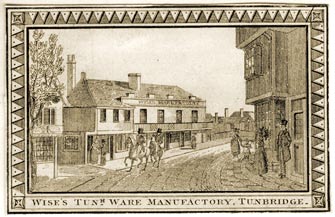


A typical highly-decorated Tunbridge Ware box (Private collection)

Paper knife
The term Tunbridge Ware originally described wooden objects made as a sideline by woodworkers in the Tonbridge area for sale to the many visitors thronging to the nearby Wells. An early form often consisted of whitewood items carrying printed labels depicting local scenes. The distinctive mosaic style, made by glueing sticks of different woods side by side and then slicing it into layers, came in the mid- 19th century, and it is this form that is now generally understood by the term ‘Tunbridge Ware’.
Nowadays the ware is usually associated with Tunbridge Wells, but there is good reason to suggest it originated in Tonbridge. In 1847 Tunbridge Ware was described as the ‘only manufacture of consequence’ established in Tonbridge town.
George Wise (1703-79), a turner, is known to have had a business in Tonbridge in 1746 at a time when the navigation of the Medway opened up greater markets for trade. With his son Thomas (1750-1807), also in the firm, he was advertising Tunbridge Ware as one of their products by 1784.

George Wise also published prints. This one is a view of the High Street, looking south, with the Manufactory on the left and the Big Bridge beyond, soon after 1818. (THS 14B.214)
The workshop, known as Wise's Tunbridge Ware Manufactory, stood at the North end of the Big Bridge on the East side. It had convenient river frontage and room for storage, workshops, residence for the family and showrooms. The woodworking firm gradually developed a specialisation in Tunbridge Ware and print publishing. Thomas’ nephew George (1779-1869) took over in 1806, consolidating their reputation for workboxes, tea caddies, games etc, made in whitewood with prints of places like Tunbridge Wells and Brighton attached. Wise’s Tonbridge business flourished and in the 1830s a retail branch was opened in Tunbridge Wells in Calverley Promenade (now Calverley Park Crescent) and another followed in the Pantiles. Wise’s opened an additional workshop in the Wells, and in 1840 there were nine manufacturers there as opposed to just one in Tonbridge. Wise’s Tonbridge premises were demolished in 1886 to widen the approach to the Bridge. Pizza Express now occupies part of the site.
>Another print of the Wise Manufactory is here, and a later photograph here.
>A set of prints published from the Manufactory by George Wise is in the THS Archives Collection. You can see them here.
Tunbridge Wells Museum holds a superb collection of Tunbridge Ware. Further information about Tunbridge Ware is on the Museum website.